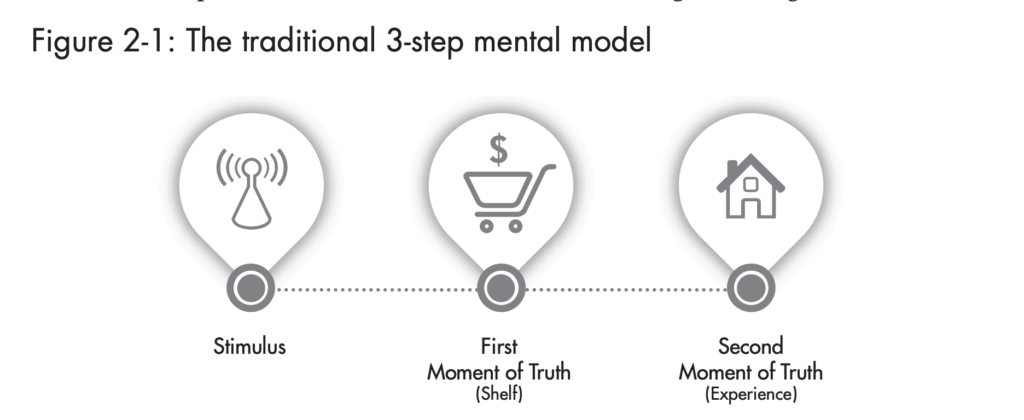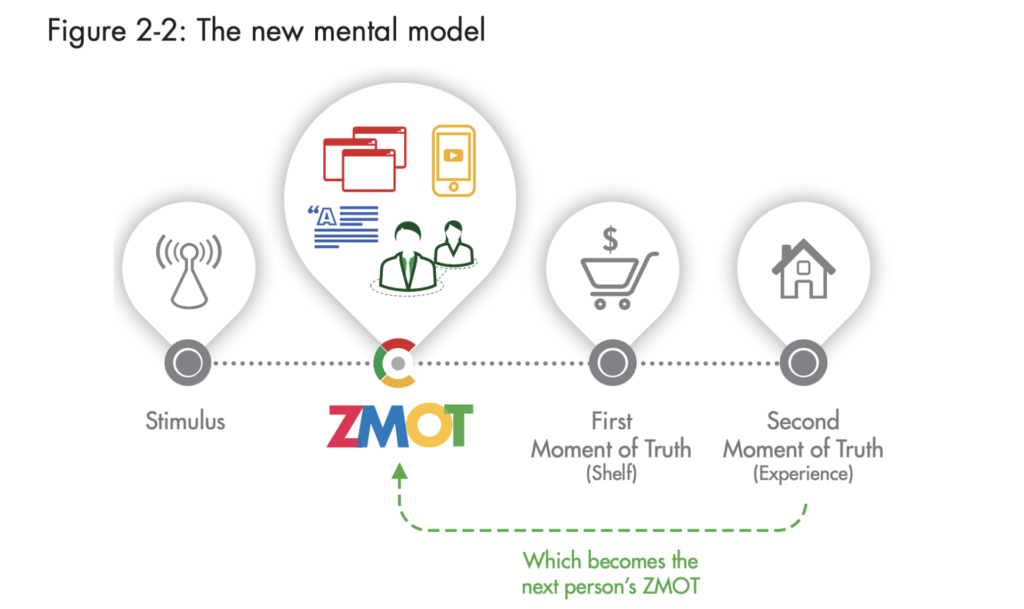The decision to buy your product takes place online

After reading the post, the most common thoughts come up: “Good, I didn't know this” or “Aha, I had heard about this before, but thank you for reminding me.” This post is of the “Aha” type. However, I believe that after reading it, you will have ideas. In 2005, an article was published that changed the established rules of marketing. The article wrote about the importance of 7 seconds for a person's self-determination when he sees goods on a store shelf. Procter & Gamble called this 7-second moment the first moment of truth. First Moment of Truth). Later, marketers discovered that there really are two moments of truth. The first, when a person sees a product on a shelf and decides whether to buy it or not. And the second, when the consumer returns home, tests the purchased item and evaluates it. The traditional marketing model consists of three stages:
- Stimulus - a person sees an advertisement for a product.
- The first moment of truth is that a person is already in the store at the store comparing goods, consulting and deciding whether to buy a product.
- The second moment of truth is that a person tries a product and forms an opinion about it, which he shares with others.

Zero Moment of Truth
Google added to this theory in 2011. Consumer behavior has been changed by the Internet. Before the first and second moments of truth occur Zero Moment of Truth(OBFUSCATION). And it is at this stage that the consumer makes a decision. Previously, the consumer, having seen an advertisement (stimulus), went to the store and saw the product on the store shelf for the first time (the first moment of truth). After buying and trying on a product, he forms an opinion about it and shares it with others (the second moment of truth). Now the ZMOT intervenes between the stimulus and the first moment of truth. The consumer, having seen an advertisement for a product, does not immediately go to the store to look at it and make a purchase. First of all, he browses the Internet, reads reviews, articles and thus collects information about the product. The Internet has enabled people to gather as much information as possible about a product and thus experience zero moment of truth. For example, a user who sees an advertisement for a phone on Facebook (stimulus) does not immediately go to the store to buy it. He browses the Internet and searches for information about him - reads reviews, compares with other phones (ZMOT). And it is at this stage that he already decides whether he will buy that phone or not, that is, he does not need to experience the first moment of truth to decide.

Answer the following questions:
Most likely, you will read reviews on the Internet (Tripadvisor, Facebook, Google, Wolt, Pincetas.lt) and only then make a decision.The same study mentioned that already in 2011, before deciding on a purchase, a person reviewed approximately 10.4 sources of information. Daugava. What does this mean? You can be a very good seller, but your sales will be hindered by your visit to the internet.We ask our customers and employees where and what information they looked for before deciding to work with us.It would be interesting to hear what sources of information on the Internet seem most relevant to you. In the meantime, I present my list:
Rekviziai.lt. Banal, but many companies here still have disorganized profiles. In our case, when they were interested in us, both customers and employees checked this resource.
Your website. This is a resource that you have complete control over. Therefore, make sure that he answers the basic needs of customers, questions or objections that arise to them.
Google My Business. Although many companies have created their profiles here, the vast majority do not fully exploit them. Did you know that here you can upload videos, photos, logo, cover photo, description, etc.?
Google search.Specifically, the first 10 search results that are displayed when you type your company name into Google. Agree that this is the first thing we do when we want to know more information. Although we do not have much control here, it must be understood that in Google search soc. networks are ranked well: ”Facebook”, ”Instagram”, ”LinkedIn”et al. Having active company accounts in these soc. networks, the first ”Google”search positions will contain links specifically to these accounts. So often there are googlingand the head of the company.
Google Images. It would be good if googling About your company, Google Images would show pictures related to your company (logo, team members, other photos).
Youtube video reviews.Often people do not want to read and prefer to watch video reviews. Especially cars, computers, telephones, etc. Film an overview of your product.
Testimonials.Customers can write reviews about you everywhere: Facebook, Google My Business, Rekviziai.lt, Trustpilot, Tripadvisor, Pincetas.lt, etc. Yes, we cannot control reviews, but I have two personal rules regarding the subject of feedback: (1) Encourage satisfied customers to leave a review (a dissatisfied customer will leave a review without your prompt). (2) Respond to negative reviews. Surely you have had situations where the owner's response in the feedback section convinced you more than the customer's own. Maybe the customer just fell back?
Repeated advertising.Although at the stage of ZMOT, most often the person himself proactively seeks information about you, but with repeated advertising it is possible to circumvent this rule a little. Repeated advertising on Facebook and Google strengthens your position. However, it is important not to chase the person with the same advertising that prompted them to engage with your content. I recommend fighting the contradictions that arise in people with the help of repeated advertising.
I understand that the amount of resources is limited and it can be difficult to properly take care of all possible communication channels. The best solution would be to call former and existing customers, employees and ask how and what information they were looking for about you. This will help you understand which channels are most relevant to you.
I wish to find my own zero moments of truth
You doubt,
or your advertising
pays off?

Order for free
Audit your ads and find out how much your potential customer can cost






